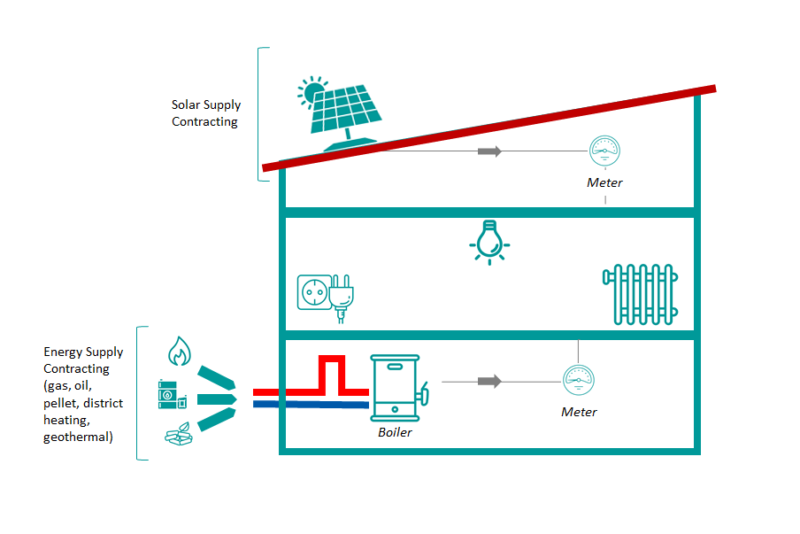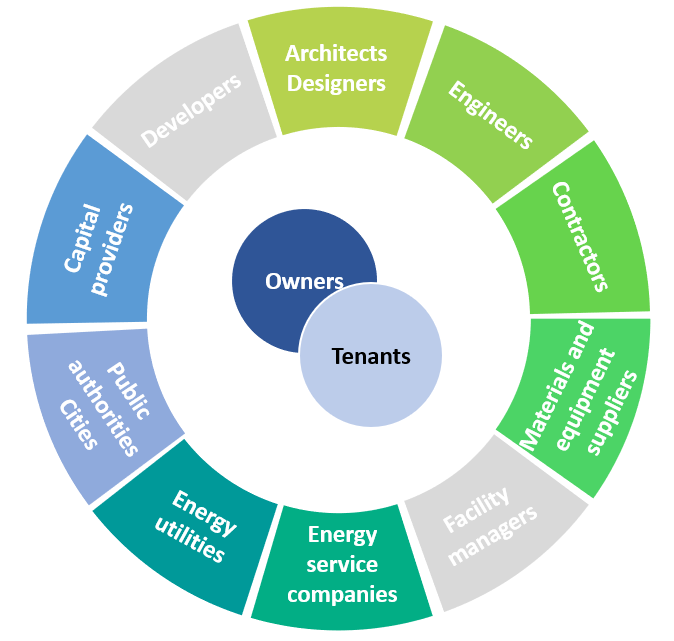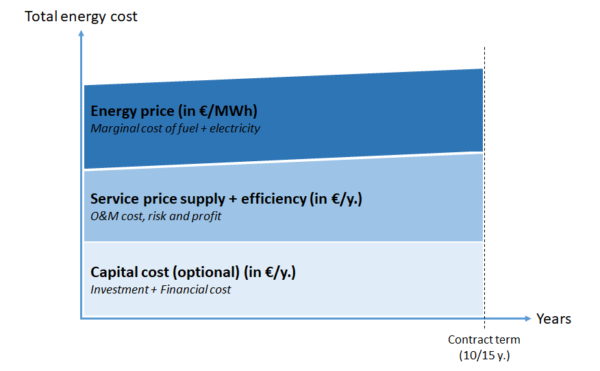Energy Supply Contracting (ESC)
Description
The Energy Supply Contracting (ESC) business model is a proven model to implement efficient supply (from fossil and/or renewable sources) in new and existing buildings of the public, industrial, commercial and large residential sectors. The goal is to bring a reduction of final energy demand, although efficiency gains are usually limited to the energy supply system.
Indeed, under an ESC model, an Energy Service Company (ESCO) is only remunerated for the useful energy output, i.e. it supplies useful energy, such as electricity, heat, or steam under a long-term contract to a building owner or building user. It is therefore in the interest of the ESCO to reduce the final energy demand. The output is measured and verified in Megawatt hours delivered. ESC models run under long-term contracts of typically ten to fifteen years, depending on the technical lifetime of the equipment deployed.
Extended project terms or building cost allowances allow to include measures with longer payback times, like facades with integrated PV modules or entire building envelopes. The building owner has the opportunity to outsource technical and economic risks related to energy supply activities (including planning, installation, operation, maintenance and financing of equipment for heating, cooling or electricity generation) to a professional party and to buy services instead of individual components. ESC often includes supply of final energy through the ESCO.
As the ESCO’s remuneration is performance based and depends on the useful energy output delivered, the ESC model provides an incentive to increase the efficiency of the energy conversion and to reduce primary energy demand. Contract covers the outcome and all costs of the services, as well as the commercial, technical and operational risks of the project. ESC may accelerate the uptake of Renewable Energy Technologies (RET) if they are cost competitive over the lifecycle of the project because ESCOs have an inherent interest to reduce life-cycle costs.
"What” (value proposition)
The benefits of ESC are a significant boost in efficiency, clear and optimized operational costs, more supply assurance and the application of the most recent safety standards. Customers do not need to worry about their energy supply since this business model gives to the building owner the opportunity to outsource technical and economic risks associated with energy supply related activities to a professional party. Objectives of the ESC service model is to optimize efficiency of the energy supply and provide security of supply. ESC often includes supply of final energy through the ESCO. Finally, there is an increase in environmental performance.
"Who” (target customer)
It is a proven model in new and  existing public, industrial, commercial and large residential buildings (for which minimum project sizes to be economically viable have been specified).
existing public, industrial, commercial and large residential buildings (for which minimum project sizes to be economically viable have been specified).
"How” (value chain, activities, resources)
Key player is the ESCO that supplies useful energy such as hot water, steam, (back-up) electricity or compressed air from a wide variety of technologies based on conventional or renewable sources.
The business model encompasses the entire process from the purchasing of fuel to the delivery and invoicing of energy. Financing, engineering design, planning, constructing, operation and maintenance of energy production plants as well as management of energy distribution are all included in the complete service package in most cases.
Technologies applied typically are efficient boilers ((bio-)gas, wood chips, and pellets), combined heat and power (CHP) systems (gas turbines and reciprocating engines), district and small-scale heating networks, solar thermal and solar PV installations. ESC is particularly suitable for the implementation of RET like solar or geothermal applications, as their energy outputs can usually be measured with little effort through electricity or heat meters.

"Why” (revenue model and cost structure)
Cost structure for the main contractor:
The ESCO is financially responsible of the implementation and operation of the energy supply package at its own expenses and risk, according to the project-specific requirements set by the client.
Revenue streams for the main contractor: 
The ESCO is remunerated for the useful energy delivered, depending on the actual consumption in combination with a flat rate for operation & maintenance. In particular, the ESCO’s remuneration is made up of the following three price components:
- Energy price (per MWh of useful energy metered), which covers the marginal ‘consumption related’ cost per MWh of useful energy supplied. To account for final energy price developments during the contractual period, the ESCO’s energy price will be adjusted by using statistical energy price indices depending on the fuel used (e.g. electricity, gas or biomass index). Thus, the risk related to final energy price development remains with the ESCO’s customer. In order to avoid selling more energy than needed, the ESCO’s calculation of the energy price should include consumption related cost only (the marginal costs), i.e. exclusively the expenditure for fuel and auxiliary electricity. If the energy price is at the marginal cost, there is no incentive for the ESCO to sell more, because the price equals the ESCO’s costs;
- The service (or basic) price for energy supply (flat rate) includes all operational cost, i.e. the cost for operation & maintenance, personal, insurance, management etc. of the energy supply infrastructure as well as entrepreneurial risk. During the contractual period, the prices are usually adjusted (typically every year retrospectively) by using statistical indices such as wage or investment materials indices. The service price for energy efficiency (flat rate) is determined in analogy to the above service price including all operational cost of the energy efficiency measures;
- If the ESCO (co)-funds the equipment, its remuneration also includes a fee for its capital costs minus any subsidies for the RET equipment which it may have received.





